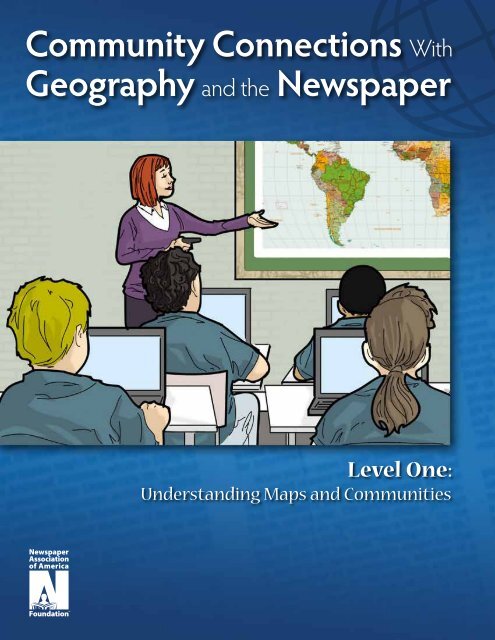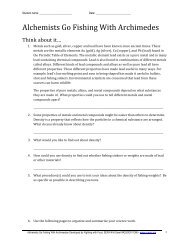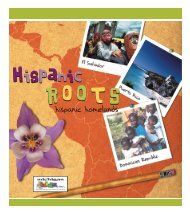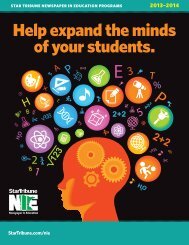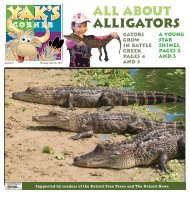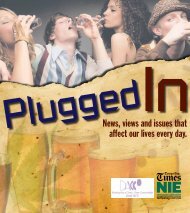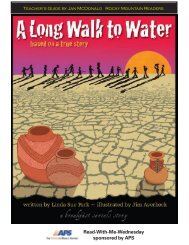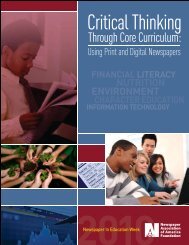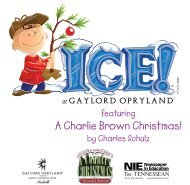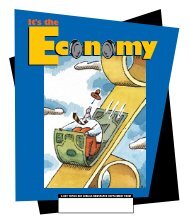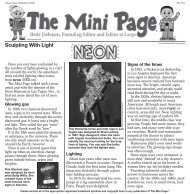to download Level One - Newspapers In Education
to download Level One - Newspapers In Education
to download Level One - Newspapers In Education
- No tags were found...
Create successful ePaper yourself
Turn your PDF publications into a flip-book with our unique Google optimized e-Paper software.
Community Connections WithGeography and the Newspaper<strong>Level</strong> <strong>One</strong>:Understanding Maps and CommunitiesAuthor/Lesson PlansMike PetersonTeachup Serial S<strong>to</strong>riesAuthor/Graphic OrganizersSandra Cook, Ed. D.North Carolina Press FoundationIllustra<strong>to</strong>rCory Thomas“Watch Your Head”Project Coordina<strong>to</strong>rMary MillerNew York News Publishers AssociationNAA FoundationSenior Vice President and Secretary/TreasurerMargaret VassilikosVice PresidentJeanne Fox-Als<strong>to</strong>nDirec<strong>to</strong>rSandy WoodcockManagerMarina HendricksCopy Edi<strong>to</strong>rBill ElsenDesignerDaniel Renero© 2011 NAA Foundation www.naafoundation.org206-361-0311-MH/DR
Table of Contents<strong>In</strong>troduction ...................................................................4Format Notes ..................................................................5Geography Standards .......................................................6Lesson 1: Mapping My Classroom ............................................8Lesson 2: Mapping My School ............................................... 12Lesson 3: My School on the Map ............................................14Lesson 4: My Communities .................................................. 16Lesson 5: My School in My Newspaper. .....................................18Lesson 6: My Home<strong>to</strong>wn in My Newspaper. ............................... 21Lesson 7: My County in My Newspaper .....................................23Lesson 8: My State in My Newspaper ....................................... 25Lesson 9: My Nation in My Newspaper ..................................... 27Lesson 10: My World in My Newspaper .....................................29Lesson 11: My Community in My Newspaper* .............................. 31Graphic Organizers .........................................................33Online Resources ............................................................55*Culminating LessonCommunity Connections | 3 | <strong>Level</strong> <strong>One</strong>
<strong>In</strong>troductionGeography and Civic EngagementGeography is at the core of social studies. Whether the subject matter is his<strong>to</strong>ry,economics, civics or current events, students must begin with a sense of where thingsare and how they fit in<strong>to</strong> the world.<strong>In</strong> social studies, civic engagement answers the question, “Why do we have <strong>to</strong> learn this?”Before we can care about the world and the people in it, before we can wonder aboutwhat came before, what is happening now and what is likely <strong>to</strong> happen in the future, wemust feel we are part of a community connected <strong>to</strong> the greater world around us.Without a sense of community, without a sense of place, civic engagement doesn’thappen. Without a sense of belonging and participating in the various communities thatsurround us, we have no reason <strong>to</strong> care or learn about them.<strong>In</strong>structional <strong>Level</strong>sThis curriculum is divided in<strong>to</strong> two levels by complexity of the concepts in each.<strong>Level</strong> <strong>One</strong> blends mapping skills with a discussion of the various communities<strong>to</strong> which everyone belongs as individuals. As students learn <strong>to</strong> make and interpretmaps, the curriculum addresses local, regional, state and national identity, as well asgovernment and community. This section is written with elementary students inmind, but the clarity of language will be helpful for anyone working <strong>to</strong> grasp thesebasic elements.<strong>Level</strong> Two is designed for students with a basic grasp of maps and a sense ofthe levels of government and geographic division. It expands that understandingwhile discussing how communities create and maintain their identities, and whileemphasizing how geography affects local economies, lifestyles and communityidentity. It is written with middle-school and older students in mind, but youngerstudents who can grasp the more complex concepts will be likely <strong>to</strong> understand thelanguage.We hope that you and your students will enjoy learning about your community throughthis curriculum and through your local newspaper.The crea<strong>to</strong>rs wish <strong>to</strong> thank the teachers who consulted on this project: CherylAnne Amendola,The Montclair Kimberley Academy, Montclair, N.J.; Marie Earnhardt, Ellen Glasgow Middle School,Alexandria, Va.; Daphne Green, Doe Elementary School, Mountain City, Tenn.; Seth Harris, ShakerJunior High School, Latham, N.Y.; Robin Hohe, Jefferson Elementary School, Allen<strong>to</strong>wn, Pa.; andJessica Parthemore, Main Elementary School, Beavercreek, Ohio.Community Connections | 4 | <strong>Level</strong> <strong>One</strong>
Format Notes<strong>Newspapers</strong><strong>Newspapers</strong> <strong>to</strong>day come in several formats, including print, electronic or “e” editions,websites and mobile applications. The term “newspaper” refers <strong>to</strong> the format you prefer<strong>to</strong> use in class.Students who have difficulty finding enough examples from <strong>to</strong>day’s newspaper shouldreview editions from previous days, either in print or in the archives for e-editions andwebsites.Other ResourcesThese lessons are written in a way that encourages use of computers and interactivewhiteboards as teaching and learning <strong>to</strong>ols. However, we have attempted <strong>to</strong> posequestions so students can complete the activities using atlases, city maps, encyclopediasand other traditional reference materials.Student handouts may be reproduced and distributed, or used with interactivewhiteboards, overheads and other projection methods.The appendix includes graphic organizers that are general and applicable <strong>to</strong> all lessons,as well as others designed for specific lessons. Review and select graphic organizers<strong>to</strong> use before, during and after your study of geography and the news. The first twoorganizers in the general category assess students’ knowledge and learning aboutcommunity before and after using the curriculum.Each lesson follows this outline:Lesson Structure Standards (National Council for Geographic <strong>Education</strong>) Anticipa<strong>to</strong>ry Set Required Materials/Equipment Direct <strong>In</strong>struction (handouts and online resources with informationfor classroom presentation) Extensions/Practice (graphic organizers) Assessment (exit slips or questions)Community Connections | 5 | <strong>Level</strong> <strong>One</strong>
Geography StandardsThis curriculum has been created with the specific intention of helping you meetnational geography learning standards. You also will find it helpful in meeting geographystandards of your state, which may vary from national standards.Activities are also likely <strong>to</strong> help you address or meet standards in other social studiessubjects, English language arts and other subject areas.These national geography standards, endorsed by the National Council for Geographic<strong>Education</strong>, were used in developing this curriculum.The geographically informed person knows and understands:The World in Spatial TermsGeography studies relationships among people, places and environments by mapping informationabout them in<strong>to</strong> a spatial context.1. How <strong>to</strong> use maps and other geographic representations, <strong>to</strong>ols and technologies<strong>to</strong> acquire, process and report information from a spatial perspective.2. How <strong>to</strong> use mental maps <strong>to</strong> organize information about people, places andenvironments in a spatial context.3. How <strong>to</strong> analyze the spatial organization of people, places and environments onEarth’s surface.Places and RegionsThe identities and lives of individuals and peoples are rooted in particular places in those humanconstructs called regions.4. The physical and human characteristics of places.5. That people create regions <strong>to</strong> interpret Earth’s complexity.6. How culture and experience influence people’s perceptions of places and regions.Physical SystemsPhysical processes shape Earth’s surface and interact with plant and animal life <strong>to</strong> create, sustainand modify ecosystems.7. The physical processes that shape the patterns of Earth’s surface.8. The characteristics and spatial distribution of ecosystems on Earth’s surface.Community Connections | 6 | <strong>Level</strong> <strong>One</strong>
Human SystemsPeople are central <strong>to</strong> geography in that human activities help shape Earth’s surface, humansettlements and structures are part of Earth’s surface, and humans compete for control of Earth’ssurface.9. The characteristics, distribution and migration of human population onEarth’s surface.10. The characteristics, distribution and complexity of Earth’s cultural mosaics.11. The patterns and networks of economic interdependence on Earth’s surface.12. The processes, patterns and functions of human settlement.13. How the forces of cooperation and conflict among people influence the divisionand control of Earth’s surface.14. How human actions modify the physical environment.Environment and SocietyThe physical environment is modified by human activities, largely as a consequence of the waysin which human societies value and use Earth’s natural resources. Human activities are alsoinfluenced by Earth’s physical features and processes.15. How physical systems affect human systems.16. The changes that occur in the meaning, use, distribution and importanceof resources.The Uses of GeographyKnowledge of geography enables people <strong>to</strong> develop an understanding of the relationships amongpeople, places and environments over time — that is, of Earth as it was, is and might be.17. How <strong>to</strong> apply geography <strong>to</strong> interpret the past.18. How <strong>to</strong> apply geography <strong>to</strong> interpret the present and plan for the future.Community Connections | 7 | <strong>Level</strong> <strong>One</strong>
Lesson 1: Mapping My ClassroomStandard: 1Anticipa<strong>to</strong>ry Set:Students will begin <strong>to</strong> learn basic map skills andthe concept of community.Required Materials/Equipment:Provide print or digital newspapers and the threestudent handouts.Direct <strong>In</strong>struction:Help students make a map of their classroom,showing the location of their desks. <strong>In</strong>troduce theconcept that a map is an overhead view of a place,with details <strong>to</strong> show where various items are.Allow 25-35 minutes for direct instruction.From the Right Here handout, read aloud theintroduction <strong>to</strong> mapping. Pause for comments asstudents discuss the concepts of place and scale.Younger students may need help understandingthe joke – that the concept of “here” is meaninglessif you don’t know where “here” is relative <strong>to</strong> otherthings.Read aloud the Mapping My Classroom handout <strong>to</strong>help students prepare <strong>to</strong> map their classroom.1. Solicit their responses <strong>to</strong> reach consensusabout the proper orientation of the blankmap and placement of the door.2. Discuss why the square representing theteacher’s desk would be larger than thesquares representing students’ desks. Thiswill form their first concrete example of theconcept of scale.Distribute the My Classroom handout. Makestudents aware of how the door’s hinge side isindicated and whether the door opens in or out.This will assist them later in understandingorientation on maps that include north, south,east and west as well as how “right” and “left” workin decoding a map.Extension/Practice:Select from the graphic organizers published inthe appendix of this curriculum: Graphic organizer (Mapping My Classroom –Mapping My Room) for Lesson 1. General organizers designed <strong>to</strong> introduce keyterms and concepts that apply <strong>to</strong> all lessonsin the curriculum.Read the directions aloud <strong>to</strong> younger studentsand have them rely on pho<strong>to</strong>s and other visualelements in the newspaper. Refer <strong>to</strong> mapswhen students have questions. If using digitalnewspapers, point out items for students <strong>to</strong> put intheir rooms and/or homes. They can draw basedon what they see on the screen. You may also usedigital newspapers <strong>to</strong> model or show studentswhat they should look for in their print editions.Assessment:Use answers <strong>to</strong> the following as exit slips <strong>to</strong>evaluate learning. I know more about … I liked what we did in class <strong>to</strong>day because …Community Connections | 8 | <strong>Level</strong> <strong>One</strong>
Lesson 1: Student Handout 1Right HereHere’s an old joke:First hiker: I think we’re lost.Second hiker: No, we’re not.We’re right here.First hiker: OK, but where’s the path?Second hiker: The path is lost.Where are you right now? Right here.Where’s that? Well, it depends.For instance: If someone is looking for you inthe school gym, you’re not there.You’re in your classroom. If someone is looking for you atyour house, you’re not there.You’re at school. If someone is looking for you inAustralia, you’re not there.You’re in the United States. And if someone is looking for youon the moon, you’re not there.You’re on Earth.But let’s not worry about the moon yet. Let’s start in your classroom.Community Connections | 9 | <strong>Level</strong> <strong>One</strong>
Lesson 1: Student Handout 2Mapping My ClassroomStart with a rectangle and pretend it isa picture of your classroom floor. Mostclassrooms are rectangles, with twowalls that are longer than the othertwo walls.Look around your classroom. Whichtwo walls are longer?Are you facing one of those long walls,or are you facing one of the two shorterwalls? Turn the piece of paper so itmatches the direction in which you aresitting.This is a picture of how the open doorwould look if you were on the ceilingstaring down at it.Now, how many doors are in yourclassroom? Draw your classroom dooror doors on the rectangle.Draw a square <strong>to</strong> show where yourteacher’s desk is.Then draw smaller squares <strong>to</strong> showthe students’ desks. Did you count themcorrectly?Which desk is yours? Circle it. That’swhere you are now – that’s “right here.”Your picture might look somethinglike this.You just drew a map of your classroom.What good is that?Well, what if you started <strong>to</strong> go homeand, just as you went outside, rememberedthat you left a book in your desk?You could ask friends <strong>to</strong> get it for you.Giving them this map would make iteasy <strong>to</strong> find your desk.But what if they didn’t know whereyour classroom is? What could youdo that would help them find yourclassroom?Community Connections | 10 | <strong>Level</strong> <strong>One</strong>
Lesson 1: Student Handout 3My ClassroomBy____________________________________________(your name)Community Connections | 11 | <strong>Level</strong> <strong>One</strong>
Lesson 2: Mapping My SchoolStandard: 1Anticipa<strong>to</strong>ry Set:Students will expand their learning with a mapshowing how <strong>to</strong> get <strong>to</strong> their classroom fromthe school entrance. <strong>In</strong> this activity, best done ingroups, they will consider the kinds of decisionsthat real mapmakers make – how much of theschool must be mapped and what features(landmarks) and other information must beincluded.Required Materials/Equipment:Provide the student handout. For mapping, usean interactive whiteboard or other projectionmethod for large-group instruction. A flip char<strong>to</strong>r large sheet of newsprint may be used for smallgroups or when projection is not possible. Prin<strong>to</strong>r digital newspapers are needed for the graphicorganizer in Extension/Practice.Direct <strong>In</strong>struction:Working in groups, students should answer thefollowing critical questions before beginning theirmaps. How much of your school needs <strong>to</strong> be on themap? All or just part of it?Students will learn that proper scale beginswith making useful decisions about the outerboundaries of a map and that a map shouldshow only the portion of an area necessaryfor its purpose. What are the important things <strong>to</strong> show onyour map? What things would help someonefind your classroom?Students will learn the concept of landmarksas a <strong>to</strong>ol for making maps useful. What else must be on your map? What canyou leave out?Students will learn that irrelevant detail, suchas diagrams of all rooms in a school, makes amap cluttered and difficult <strong>to</strong> use.Build on what students learned about scale inLesson 1 when they were required <strong>to</strong> fit desks in<strong>to</strong>a diagram of their classroom. Hold a more formaldiscussion about the use of scale. Your approachmay be either general – “Is that a long hallway?” –or mathematical, actually measuring distancesand converting them <strong>to</strong> an appropriate scale.Allow 20-30 minutes for direct instruction.Extension/Practice:Select from graphic organizers published in theappendix of this curriculum: Graphic organizer (Mapping My School –Arranging My Home) for Lesson 2. General organizers designed <strong>to</strong> introduce keyterms and concepts that apply <strong>to</strong> all lessonsin the curriculum.Assessment:Use answers <strong>to</strong> the following as exit slips <strong>to</strong>evaluate learning. I learned how <strong>to</strong> … I want <strong>to</strong> know more about …Community Connections | 12 | <strong>Level</strong> <strong>One</strong>
Lesson 2: Student HandoutMapping My SchoolJust as a map of your classroom couldhelp someone find your desk, a map ofyour school could help someone findyour classroom.Before you begin <strong>to</strong> draw, talk <strong>to</strong>members of your group and determineanswers <strong>to</strong> these questions:How much of your school needs <strong>to</strong> beon the map?All of it, or just part of it?If your classroom is at the front of theschool, maybe you don’t need <strong>to</strong> drawthe whole school. If it’s in the back,maybe you do. What do you think?What are the important things <strong>to</strong> showon your map? What things would helpsomeone find your classroom?Things found easily are calledlandmarks. <strong>In</strong> most schools, the gymand library are landmarks because theyare big and easy <strong>to</strong> find. The office is animportant landmark because visi<strong>to</strong>rsmust go there as soon as they enter thebuilding.People use landmarks <strong>to</strong> help othersfind their way. They might say, “Turnright at the library” or “Go three doorspast the gym.”What are landmarks in your schoolthat would help people understandyour map and find your classroom?The map of your classroom was arectangle. But what shape will yourschool map be?What else must be on your map?You don’t need <strong>to</strong> draw all of theclassrooms and desks. That wouldtake <strong>to</strong>o long and make your map <strong>to</strong>ocrowded.But you might want <strong>to</strong> draw just thedoors so a person walking down thehall could count doors <strong>to</strong> help findyour room. Those doors aren’t really“landmarks,” but they would make iteasier <strong>to</strong> find your room. Add wordssuch as “library” or “Room 212” <strong>to</strong> helppeople know where they are on themap.Ready? Have you made your decisions?Draw a map that would help someonefind your classroom.Community Connections | 13 | <strong>Level</strong> <strong>One</strong>
Lesson 3: My School on the MapStandard: 1Anticipa<strong>to</strong>ry Set:Students will move from their own diagrams <strong>to</strong>actual maps, seeing the connection between thetwo and understanding that a map is a picture ofan area seen from above.Required Materials/Equipment:Use online mapping resources if available.However, you can modify the activity and usea city map. Appropriate alternatives wouldbe <strong>to</strong> enlarge the map on a pho<strong>to</strong>copier andmake copies for each student, or <strong>to</strong> create atransparency for use on an overhead projec<strong>to</strong>r.Make an additional map at less magnification,either copying for distribution or formatting foroverhead use. Print or digital newspapers areneeded for the graphic organizer in Extension/Practice.Direct <strong>In</strong>struction:Follow the steps outlined here <strong>to</strong> explain thelocation of the school <strong>to</strong> students and engagethem with technology. Allow 30-40 minutes fordirect instruction (time may vary significantlydepending on <strong>In</strong>ternet use andconnection speed). You can useGoogle Maps, Google Earth orMapQuest, but try each before class<strong>to</strong> make sure they show your schoolaccurately. Choose the one thatseems most user-friendly.allow users <strong>to</strong> add comments. If you plan <strong>to</strong> useone of these, check the comments <strong>to</strong> make surenothing is displayed that you don’t want students<strong>to</strong> read. You can avoid this by using MapQuest orby scrolling on the map of your <strong>to</strong>wn rather thansearching for the school by name.Help students understand map orientation usingthe street map format, showing all street namesin a scale limited <strong>to</strong> a few blocks surrounding yourschool.1. <strong>In</strong> mapping their classroom, students turnedthe picture so the wall they faced was at the<strong>to</strong>p. Explain that on maps, “north” is at the <strong>to</strong>p.2. Beginning with the street in front of theschool, point out streets they know and tracewith them any familiar routes, such as walksthey may take regularly <strong>to</strong> a library, park orother neighborhood resource. Use commonterminology such as “right” and “left” ratherthan compass points.Note: Google Maps and Google EarthCommunity Connections | 14 | <strong>Level</strong> <strong>One</strong>
Switch <strong>to</strong> the aerial view and review streets and routes you have just discussed.Remind students of landmarks they used in mapping their school. Point out orsolicit from them examples of landmarks on the aerial view. For those usingpaper maps, solicit suggestions for landmarks and add them <strong>to</strong> the map.Toggle the minus but<strong>to</strong>n <strong>to</strong> zoom out, showinghow their school and its neighborhood fit in<strong>to</strong> thelarger community. Using compass points, ratherthan “right” and “left,” point out landmarks such asmajor highways, rivers or lakes, sports stadiumsand other features of the larger community.Extension/Practice:Select from graphic organizers published in theappendix of this curriculum: Graphic organizer (My School on the Map –Landmarks) for Lesson 3. General organizers designed <strong>to</strong> introduce keyterms and concepts that apply <strong>to</strong> all lessonsin the curriculum.Assessment:Use answers <strong>to</strong> the following as exit slips <strong>to</strong>evaluate learning. I was surprised <strong>to</strong> learn … I would like <strong>to</strong> know more about …Community Connections | 15 | <strong>Level</strong> <strong>One</strong>
Lesson 4: My CommunitiesStandards: 2, 4Anticipa<strong>to</strong>ry Set:Students will connect geographic areas withcommunities of common interest, seeing theconnections between sense of place and sense ofbelonging.Required Materials/Equipment:Provide the student handout and print or digitalnewspapers.Direct <strong>In</strong>struction:With your students, discuss the many large andsmall communities <strong>to</strong> which they belong. Solicitexamples from students of such groups. Examplesmight be your class, scouts or 4-H, sports teams,place of worship or religious affiliation, and/oryouth theater groups. Examples of less formalgroups might be those taking art or music lessons,those who play at an area youth center, thosevolunteering for a community project, etc.Students are also members of family groups,including their nuclear families and theirextended families of grandparents, aunts anduncles, cousins, etc. Students may be comfortablewith mentioning they have two homes and twofamilies.Using Venn diagrams, discuss how thesecommunities may or may not overlap. Forexample, members of a dance class may attenddifferent schools, while scouts are often centeredin a particular school. Although scale will vary,most groups are defined in some sense bygeography, ranging from a classroom <strong>to</strong> a nationor even the world. Allow 25-35 minutes for directinstruction.Have students work alone, in small groups or as aclass <strong>to</strong> locate communities in their newspapersas the handout directs.Extension/Practice:Select from graphic organizers published in theappendix of this curriculum: Graphic organizer (My Communities – GroupEvents) for Lesson 4. General organizers designed <strong>to</strong> introduce keyterms and concepts that apply <strong>to</strong> all lessonsin the curriculum.Consider having students interview adults <strong>to</strong>find out if they participate in online communities(such as social networks, online reunion andalumni sites, hobby groups, etc.). Students shouldask what brings people <strong>to</strong>gether in virtualcommunities.Assessment:Use answers <strong>to</strong> the following as exit slips <strong>to</strong>evaluate learning. I enjoyed learning about … I was confused when …Community Connections | 16 | <strong>Level</strong> <strong>One</strong>
Lesson 4: Student HandoutMapping CommunitiesPeople live in communities. Your <strong>to</strong>wnis a community, but you also belong <strong>to</strong>smaller and larger communities. Yourclassroom is a kind of community. It is agroup of people who come <strong>to</strong>gether fora reason.Your classroom is part of a largercommunity – your school, which is alsoa group of people who get <strong>to</strong>getherregularly. You probably don’t knoweveryone in the school, and you know thepeople in your classroom better, but it’sstill a community <strong>to</strong> which you belong.Your school is part of an even largercommunity – your school district. Mostschool districts have more than oneschool. <strong>In</strong> some, school buildings are close<strong>to</strong>gether. <strong>In</strong> others, they are quite farapart. You certainly don’t know all of thepeople in your school district. But that isstill a community <strong>to</strong> which you belong.You probably also belong <strong>to</strong> othercommunities. Perhaps you’re a scout ora member of a sports team. You mightattend a church, temple or mosqueregularly. Maybe you’re part of a theatergroup or the Boys and Girls Club.Even though you aren’t old enough <strong>to</strong>vote or have a job, you’re also part of thebigger world outside. You live in a <strong>to</strong>wnor city that is part of a county, which ispart of a state that is part of a nationthat is part of the world. These are allcommunities, and you are part of all ofthem.So let’s start looking for communities inthe newspaper.Look in the newspaper <strong>to</strong> findcommunities you belong <strong>to</strong>, then listthem here.________________________________________________________________________________________________________________________________________________________________________________________________________________________________Community Connections | 17 | <strong>Level</strong> <strong>One</strong>
Lesson 5: My School in My NewspaperStandard: 4Anticipa<strong>to</strong>ry Set:Students will learn <strong>to</strong> relate what they hear andsee about a school <strong>to</strong> the place it occupies on thephysical map and in their mental maps of theircommunity.Required Materials/Equipment:Provide the student handout and print or digitalnewspapers.Direct <strong>In</strong>struction:Ask students <strong>to</strong> name schools in your district.This not only allows them <strong>to</strong> demonstrate theirknowledge, but also reinforces their mental mapswhen you ask where each school building is beforelooking it up on the map. Students’ mental mapsof your district will vary because of where theirparents work, whether they belong <strong>to</strong> more thanone household and other reasons involving thedifferent communities in their lives.Look up each school on the map and discussrelative distances. <strong>In</strong> particular, talk about wherestudents will attend school in the future, formiddle or high school, and about the location ofthose buildings relative <strong>to</strong> your school and <strong>to</strong> theirhomes. Who will travel farthest <strong>to</strong> school? Whowill be closest <strong>to</strong> his/her new school?Have students work in small groups duringtheir search for s<strong>to</strong>ries and pho<strong>to</strong>s <strong>to</strong> completethe handout. Students should be involved inconversation and peer assistance.After students have reported on their search fornewspaper s<strong>to</strong>ries about their school districtand its schools, discuss how those s<strong>to</strong>ries showthe schools being part of the larger community.For example, an engagement announcementmight show how the friendship between twohigh-school alumni evolved after graduation. Asports s<strong>to</strong>ry might show two regional schoolsinteracting with members of their communitiesattending the game. Allow 30-40 minutes fordirect instruction.Extension/Practice:Select from graphic organizers published in theappendix of this curriculum: Graphic organizer (My School in MyNewspaper – Sports News) for Lesson 5. General organizers designed <strong>to</strong> introduce keyterms and concepts that apply <strong>to</strong> all lessonsin the curriculum.Assessment:Use answers <strong>to</strong> the following as exit slips <strong>to</strong>evaluate learning. I think <strong>to</strong>day’s lesson was … I had a hard time when …Community Connections | 18 | <strong>Level</strong> <strong>One</strong>
Lesson 5: Student HandoutMy School in My NewspaperLet’s start with your school – but not just your school building.Let’s look for your school district.1. What is your school district called?__________________________________________________________________2. How many school buildings are included in your district? List each.________________________________________________________________________________________________________________________________________________________________________________________________________________________________________________________________Can you find each of those schools on the map? Is geography part of thename of your school district or any of the buildings in it?Look through the newspaper for pho<strong>to</strong>s and s<strong>to</strong>ries about your school district andthe schools in it. Can you find at least one mention of your schools in each of thesecategories? Make notes about each item you find.NEWS____________________________________________________________________________________________________________________________________FEATURES____________________________________________________________________________________________________________________________________CALENDAR ITEMS____________________________________________________________________________________________________________________________________Community Connections | 19 | <strong>Level</strong> <strong>One</strong>
Lesson 5: Student Handout (Continued)SPORTS____________________________________________________________________________________________________________________________________OBITUARIES____________________________________________________________________________________________________________________________________HELP–WANTED ADS____________________________________________________________________________________________________________________________________<strong>In</strong> which category did you find the first mention of a school in your district?______________________________________________________________________________________________________________________________________________________________________________________________________<strong>In</strong> which category did you have the hardest time finding a mention of a school?______________________________________________________________________________________________________________________________________________________________________________________________________Community Connections | 20 | <strong>Level</strong> <strong>One</strong>
Lesson 6: My Home<strong>to</strong>wn in My NewspaperStandards: 4, 5Anticipa<strong>to</strong>ry Set:Students will explore the concept of amunicipality as a governmental unit and as acommunity.Required Materials/Equipment:Provide the student handout and print or digitalnewspapers.Direct <strong>In</strong>struction:Explain that the term “home<strong>to</strong>wn” is purposelyvague because students may live in a city, <strong>to</strong>wn,village or other municipal unit. <strong>In</strong>struct studentsappropriately, depending on the structure in yourarea.For example, White River Junction, Vt., is anunincorporated village within the <strong>to</strong>wn ofHartford. It is located in a significant place – atthe junction of two interstate highways – andhas its own post office, ZIP code and U.S. Censusdata. However, White River Junction has noactual governmental status and is governed aspart of Hartford. It would appear as a dateline innewspapers, as would Hartford. Students fromWhite River Junction would mark s<strong>to</strong>ries andpictures for White River Junction as well as s<strong>to</strong>riesand pho<strong>to</strong>s for Hartford.Have students complete the handout, findingpho<strong>to</strong>s and s<strong>to</strong>ries about their <strong>to</strong>wns. They maywork on their own, in teams or small groups, or asa class. Allow 50-60 minutes for direct instruction.Extension/Practice:Select from graphic organizers published in theappendix of this curriculum: Graphic organizer (My Home<strong>to</strong>wn in MyNewspaper – Place Words) for Lesson 6. General organizers designed <strong>to</strong> introduce keyterms and concepts that apply <strong>to</strong> all lessonsin the curriculum.Assessment:Use answers <strong>to</strong> the following as exit slips <strong>to</strong>evaluate learning. I was surprised when I learned myhome<strong>to</strong>wn … I wonder why …Community Connections | 21 | <strong>Level</strong> <strong>One</strong>
Lesson 6: Student HandoutMy Home<strong>to</strong>wn in My NewspaperLet’s look at your home<strong>to</strong>wn.What’s your home address? (If you livein more than one place, use the addressclosest <strong>to</strong> your school.)________________________________________________________________<strong>In</strong> what <strong>to</strong>wn (or city) do you live? Findyour home on the map.Look through the newspaper forpho<strong>to</strong>s and s<strong>to</strong>ries about yourhome<strong>to</strong>wn. Below, write the headlinesor describe the pho<strong>to</strong>s for threeexamples.1. ______________________________________________________________2. ______________________________________________________________3. ______________________________________________________________<strong>Newspapers</strong> sometimes include amap <strong>to</strong> show readers where a s<strong>to</strong>ryhappened. Draw a map that would helpnewspaper readers from other <strong>to</strong>wnsknow where your <strong>to</strong>wn is.Hint: Readers need <strong>to</strong> know wherethings happen. News and features<strong>to</strong>ries sometimes have a “dateline,”which means that before the s<strong>to</strong>ryactually begins, you see the name ofthe <strong>to</strong>wn where the s<strong>to</strong>ry takes place.If not, you might find the name of the<strong>to</strong>wn very early in the s<strong>to</strong>ry or in thecaption below a pho<strong>to</strong>.The dateline is circled here.Does your newspaper apply datelines <strong>to</strong>local s<strong>to</strong>ries, or do you find the namesof <strong>to</strong>wns early in local s<strong>to</strong>ries?How many different local places did youfind? ______Which place is least familiar <strong>to</strong> you?________________________________Find that place on a map.Community Connections | 22 | <strong>Level</strong> <strong>One</strong>
Lesson 7: My County in My NewspaperStandards: 11, 12, 13Anticipa<strong>to</strong>ry Set:Students will explore the concept of county (orparish in Louisiana) as a unit of government thatincludes several <strong>to</strong>wns.Required Materials/Equipment:Provide the student handout and print or digitalnewspapers.Direct <strong>In</strong>struction:Have students find information about theircounty in their newspapers and complete thehandout.Through classroom discussion, newspaperexploration and map work, students shouldbe made aware that a county takes on certainresponsibilities individual <strong>to</strong>wns cannot handlealone. These might include providing roadmaintenance and other services, as well asmaintaining cultural and recreational facilitiessuch as parks, libraries and community colleges. <strong>In</strong>rural areas, more than one county may cooperate<strong>to</strong> provide some of these community elements.Students should be encouraged <strong>to</strong> recognizethe cooperative nature of governmental unitsas part of a community and <strong>to</strong> seek evidence ofthat cooperation. Offer an example: A communitycollege based in one county may use the county’sname as part of its own, while a college governedby more than one county would likely choosea more regional name. The name of the schoolsuggests the community it is chiefly intended <strong>to</strong>serve.Students should also be encouraged <strong>to</strong> bring theirown experiences <strong>to</strong> this lesson. They may knowof county facilities that are free for residentsbut charge a fee <strong>to</strong> nonresidents, or they may beaware that people must travel <strong>to</strong> a particularmunicipality <strong>to</strong> renew a driver’s license.Students should learn the term by which the sea<strong>to</strong>f county government is designated in your state.Common terms include “county seat,” “shire <strong>to</strong>wn”and “parish seat.” Allow 45-55 minutes for directinstruction.Extension/Practice:Select from graphic organizers published in theappendix of this curriculum: Graphic organizer (My County in MyNewspaper – KWL) for Lesson 7. General organizers designed <strong>to</strong> introduce keyterms and concepts that apply <strong>to</strong> all lessonsin the curriculum.Assessment:Use answers <strong>to</strong> the following as exit slips <strong>to</strong>evaluate learning. The most important thing I learned about mycounty was … I want <strong>to</strong> know more about …Community Connections | 23 | <strong>Level</strong> <strong>One</strong>
Lesson 7: Student HandoutMy County in My NewspaperLet’s look at your home county.A county is an area that includes several <strong>to</strong>wns.Your county may be responsible for the sheriff’sdepartment and a court system, for maintainingsome roads and water systems, and for otherthings that reach beyond a single <strong>to</strong>wn, such as acommunity college.Find your home<strong>to</strong>wn on the map and see what county it is in, or look up your home<strong>to</strong>wnonline or in an atlas. Does your school district include more than one county?Look through the newspaper for pho<strong>to</strong>s and s<strong>to</strong>ries about your county. Below,write the headlines or describe the pho<strong>to</strong>s for three examples.1. _________________________________________________________________2. _________________________________________________________________3. _________________________________________________________________How many references <strong>to</strong> different <strong>to</strong>wns and/or communities in your county doesyour newspaper include? Does it mention yours?____________________________________________________________________________________________________________________________________Community Connections | 24 | <strong>Level</strong> <strong>One</strong>Hint: It may be difficult <strong>to</strong> find yourcounty on a map. However, the U.S.Census Bureau has county maps onits website.This is Onslow County, N.C. This mapdoesn’t show every <strong>to</strong>wn in OnslowCounty, but if you looked at a roadmap or on the MapQuest website,you could compare the two anddetermine what other <strong>to</strong>wns are inthe county but aren’t on this map.
Lesson 8: My State in My NewspaperStandards: 4, 5Anticipa<strong>to</strong>ry Set:Students will explore the state as a political entityand see how scale begins <strong>to</strong> create a sense ofregional identity.Required Materials/Equipment:Provide the student handout and print or digitalnewspapers.Direct <strong>In</strong>struction:As students prepare <strong>to</strong> search for newspapers<strong>to</strong>ries about their state, guide discussion <strong>to</strong> coverthe political body of the state and the identityshared by state residents. Solicit suggestionsabout what gives your state identity – itsnickname, the name by which residents areknown and his<strong>to</strong>rical elements of popular culture.Review and reinforce concepts taught in otherlessons. Return <strong>to</strong> the map that shows a scaledrawing of your school and its neighborhood. Asyou review what has been covered – school, <strong>to</strong>wn,county – zoom <strong>to</strong> those levels. <strong>In</strong> this example, westart with Lincoln Elementary School, then zoom<strong>to</strong> show Evansville, <strong>In</strong>d., and then zoom even more<strong>to</strong> show Evansville’s position within <strong>In</strong>diana andits proximity <strong>to</strong> Kentucky and Illinois.TIP: For the question on distance <strong>to</strong> thestate capital, you may have students use anonline route-mapping resource <strong>to</strong> determinehighway miles, or a ruler and mileage scale <strong>to</strong>find mileage “as the crow flies.” This exercisewill help <strong>to</strong> reinforce the concept of scale.Allow 35-45 minutes for direct instruction.Extension/Practice:Select from graphic organizers published in theappendix of this curriculum: Graphic organizer (My State in My Newspaper– Geography Clues) for Lesson 8. General organizers designed <strong>to</strong> introduce keyterms and concepts that apply <strong>to</strong> all lessonsin the curriculum.Assessment:Use answers <strong>to</strong> the following as exit slips <strong>to</strong>evaluate learning. The most interesting thing I learned aboutmy state was … I wonder about …Community Connections | 25 | <strong>Level</strong> <strong>One</strong>
Lesson 8: Student HandoutMy State in My NewspaperLet’s look at your state. First,mark it on this map. Thenwrite down the followinginformation and tell whereyou found it.My state’s name___________________________My state’s population______________________My state’s capital city______________________It is_______________ miles from my <strong>to</strong>wn <strong>to</strong> thestate capital.Look through the newspaper for pho<strong>to</strong>s and s<strong>to</strong>ries about your state. Below, writethe headlines or describe the pho<strong>to</strong>s for three examples.1.__________________________________________________________________2._________________________________________________________________3._________________________________________________________________S<strong>to</strong>ries about the state may deal with laws and government, professional sportsteams, state universities, parks and recreation or other <strong>to</strong>pics. What <strong>to</strong>pics do thes<strong>to</strong>ries about your state cover? Write them on the back of this sheet.Community Connections | 26 | <strong>Level</strong> <strong>One</strong>
Lesson 9: My Nation in My NewspaperStandards: 4, 5, 6Anticipa<strong>to</strong>ry Set:Students will explore the concept of “United States”and connections among the various states andtheir own. Students will share their knowledge ofclimate, cus<strong>to</strong>ms and <strong>to</strong>pography in other statesand how they have learned about distant places,reinforcing the connection between their mentalmaps and the formal map of the United States.Required Materials/Equipment:Provide the student handout and print or digitalnewspapers.Direct <strong>In</strong>struction:Before students explore the newspaper, showthem the outline map of the United States andask them <strong>to</strong> volunteer whether they have lived,or have family living, in other states. Mark eachstate named, asking for a show of hands by otherstudents who have lived there or who have familythere.Do students have observations about these states?What can they tell the class about differences incus<strong>to</strong>ms, <strong>to</strong>pography or climate between anotherstate and yours? Can they share informationabout landmarks and special places in thosestates?Count the number of states marked on your map.Do patterns emerge, such as having most of thestates marked in one part of the country? Arethere bordering states with no contacts?Have students work in teams, small groups or as aclass <strong>to</strong> find pho<strong>to</strong>s and s<strong>to</strong>ries about other statesin their newspapers and complete the handout.After students have completed the newspaperexercise, discuss the s<strong>to</strong>ries and pho<strong>to</strong>s theyidentified. Ask: How many of those s<strong>to</strong>ries orpho<strong>to</strong>s are from states marked on your map?Allow 35-45 minutes for direct instruction,including online instruction.Online instruction: map gameshttp://www.maps.com/FunFacts.aspx?nav=FF#On this website, you’ll find fun map gamesand puzzles <strong>to</strong> play: Name state capitals,put <strong>to</strong>gether state jigsaw puzzles, completecrossword puzzles and more. <strong>In</strong>cluded are U.S.and world map games.Extension/Practice:Select from graphic organizers published in theappendix of this curriculum: Graphic organizer (My Nation in MyNewspaper – Comparing Two States) forLesson 9. General organizers designed <strong>to</strong> introduce keyterms and concepts that apply <strong>to</strong> all lessonsin the curriculum.Assessment:Use answers <strong>to</strong> the following as exit slips <strong>to</strong>evaluate learning. The most surprising thing I learned about theUnited States was … I wish I knew more about …Community Connections | 27 | <strong>Level</strong> <strong>One</strong>
Lesson 9: Student HandoutMy Nation in My NewspaperYou know what a state is. What does the word “united” mean? Andwhat does “United States of America” mean?Do you have friends or relatives living in other states? Have you evervisited other states? On this map, mark an “R” on each state where youhave a relative. Mark a “V” on each state you have visited.Look through the newspaper for pho<strong>to</strong>s and s<strong>to</strong>ries about the United States orpeople and things from other states. Below, write the headlines or describe thepho<strong>to</strong>s for three examples.1. _________________________________________________________________2._________________________________________________________________3._________________________________________________________________What do the pho<strong>to</strong>s and s<strong>to</strong>ries tell you about life in the United States?______________________________________________________________________________________________________________________________________________________________________________________________________Community Connections | 28 | <strong>Level</strong> <strong>One</strong>
Lesson 10: My World in My NewspaperStandards: 4, 5, 6Anticipa<strong>to</strong>ry Set:Students will explore the concept of nations andthe connections between various nations of theworld and their own. Students will share theirknowledge of climates, cus<strong>to</strong>ms and <strong>to</strong>pographyin other nations and how they have learnedabout distant places, reinforcing the connectionbetween their mental maps and the formalmap of the world (or the globe, still an excellentrepresentation of Earth).Required Materials/Equipment:Provide the student handout and print or digitalnewspapers.Direct <strong>In</strong>struction:Show the outline map of the world and askstudents <strong>to</strong> volunteer whether they have lived, orhave family living, in other countries. Mark eachnation named, asking for a show of hands by otherstudents who have lived there or who have familythere.Do students have observations about thesenations? What can they tell the class aboutdifferences in cus<strong>to</strong>ms, <strong>to</strong>pography or climatesbetween these nations and the United States?Can they share information about landmarks andspecial places in those countries? Ask studentshow they learned these things and differentiateamong firsthand knowledge, secondhand reportsand stereotypes that may not be factual or timely.Have students work in teams, small groups oras a class <strong>to</strong> find pho<strong>to</strong>s and s<strong>to</strong>ries about othercountries in their newspapers and completethe handout. Explain that some communitynewspapers focus on local news. <strong>In</strong> thosenewspapers, students are more likely <strong>to</strong> findpho<strong>to</strong>s and s<strong>to</strong>ries about the impact that eventsin other countries have on the local community.They also may discover people and things thatcame <strong>to</strong> their community, <strong>to</strong>wn, county and/orstate from other countries.Extension/Practice:Select from graphic organizers published in theappendix of this curriculum: Graphic organizer (My World in MyNewspaper – Advantages and Disadvantages)for Lesson 10. General organizers designed <strong>to</strong> introduce keyterms and concepts that apply <strong>to</strong> all lessonsin the curriculum.Assessment:Use answers <strong>to</strong> the following as exit slips <strong>to</strong>evaluate learning. The most important thing I learned aboutthe world was … I’d like <strong>to</strong> explore …Count the number of nations marked.Students should volunteer information so anywho are sensitive about family background orconcerned about relatives on deployment maychoose whether <strong>to</strong> remain silent.Community Connections | 29 | <strong>Level</strong> <strong>One</strong>
Lesson 10: Student HandoutMy World in My NewspaperDo you have friends or relatives livingin other nations? Have you ever visitedother nations? On this map, mark an“R” on each nation where you have arelative. Mark a “V” on each nation youhave visited.Look through the newspaper forpho<strong>to</strong>s and s<strong>to</strong>ries from outside theUnited States or about people andthings that came from other nations.Below, write the headlines or describethe pho<strong>to</strong>s for three examples.1. _________________________________________________________________2. _________________________________________________________________3. _________________________________________________________________What do the pho<strong>to</strong>s and s<strong>to</strong>ries tell you about life outside the United States?______________________________________________________________________________________________________________________________________________________________________________________________________Community Connections | 30 | <strong>Level</strong> <strong>One</strong>
Lesson 11: My Community in My NewspaperStandards: 3, 6(Culminating Lesson)Anticipa<strong>to</strong>ry Set:Students will review and show mastery of theconcepts of school, <strong>to</strong>wn, county, state, nationand world. They will demonstrate their ability <strong>to</strong>locate these places on maps.Required Materials/Equipment:Provide the student handout and print or digitalnewspapers.Direct <strong>In</strong>struction:Have students work on their own or in teams,small groups or as a class <strong>to</strong> find examples in theirnewspapers <strong>to</strong> complete the handout.Online instruction:Community in His<strong>to</strong>ryhttp://community.rice.eduThis page is a cooperative effort between RiceUniversity and local schools <strong>to</strong> create aframework for conducting oral his<strong>to</strong>ries andfostering a sense of community. The siteprovides lots of how-<strong>to</strong> information from asuccessful series of oral his<strong>to</strong>ry projects.<strong>In</strong>vite students <strong>to</strong> share an answer, movingfrom school through world. As each child sharesan example from the newspaper, ask students<strong>to</strong> identify the best map on which <strong>to</strong> find thatlocation and then <strong>to</strong> show the location of thes<strong>to</strong>ry, pho<strong>to</strong> or advertisement on that map.Extension or practice:Select from graphic organizers published in theappendix of this curriculum: Two graphic organizers (My Community inMy Newspaper — Cause and Effects and/orImproving Community) for Lesson 11. General organizers designed <strong>to</strong> introduce keyterms and concepts that apply <strong>to</strong> all lessonsin the curriculum.Assessment:Use answers <strong>to</strong> the following as exit slips <strong>to</strong>evaluate learning. Now that I know more about mycommunity, I think … The thing I liked best about <strong>to</strong>day’slesson was …This concludes the <strong>Level</strong> <strong>One</strong> unit. Students should now know how maps are made and how <strong>to</strong>interpret basic information on a map. They should be able <strong>to</strong> translate their mental maps in<strong>to</strong> actualmaps. They should also have a sense of how real-life events, people and things translate in<strong>to</strong> places on amap and, if you have used online mapping resources, be able <strong>to</strong> move with comfort between maps andaerial pho<strong>to</strong>graphy.<strong>In</strong> <strong>Level</strong> Two, students will be exposed <strong>to</strong> the human dimensions of geography – why people choose<strong>to</strong> live in a particular place and how people interact with their environment. The language and conceptsin <strong>Level</strong> Two are somewhat more complex than those in <strong>Level</strong> <strong>One</strong>. If you think it is above the skill levelsof your students as presented, then use the guide for ideas on how <strong>to</strong> teach the concepts and use theresources included in it.Community Connections | 31 | <strong>Level</strong> <strong>One</strong>
Lesson 11: Student HandoutMy Community in My NewspaperYou belong <strong>to</strong> many communities.Some are quite small. Some are verylarge. But each community you belong<strong>to</strong> is part of who you are.Look through the newspaper forpho<strong>to</strong>s, s<strong>to</strong>ries and advertisementsabout the communities that help makeup your life.Below, write the headlines or describe the pho<strong>to</strong>s or ads for each example you find.My school__________________________________________________________A place I go often ____________________________________________________A place I go sometimes ________________________________________________A s<strong>to</strong>re where I shop __________________________________________________My <strong>to</strong>wn ___________________________________________________________A different <strong>to</strong>wn where a friend lives ____________________________________My county __________________________________________________________My state ___________________________________________________________Another state _______________________________________________________The United States ____________________________________________________A different nation ____________________________________________________What else did you find in the newspaper that describes life in your community?____________________________________________________________________________________________________________________________________________________________________________________________________________________________________________________________________________________________________________________________________________________________________________________________________________Community Connections | 32 | <strong>Level</strong> <strong>One</strong>
Graphic OrganizersThe following graphic organizers provide students with background for effective use ofnewspapers and geography lessons in this guide. The general organizers apply <strong>to</strong> any lesson,while the other organizers extend the work on concepts in specific lessons.GeneralPAGE34 Before – What Do You Know?35 After – What Do You Know?36 Get Acquainted With Community <strong>Newspapers</strong>37 Understanding Community38 The Root Word for “Community”39 The Root for “Geography”40 How Words Develop41 Time and Place42 WeatherSpecificPAGELesson43 Mapping My Classroom Mapping My Room Lesson 144 Mapping My School Arranging My Home Lesson 245 My School on the Map Landmarks Lesson 346 My Communities Group Events Lesson 447 My School in My Newspaper Sports News Lesson 548 My Home<strong>to</strong>wn in My Newspaper Place Words Lesson 649 My County in My Newspaper KWL Lesson 750 My State in My Newspaper Geography Clues Lesson 851 My Nation in My Newspaper Comparing Two States Lesson 952 My World in My Newspaper Advantages and Disadvantages Lesson 1053 My Community in My Newspaper Cause and Effects Lesson 1154 My Community in My Newspaper Improving Community Lesson 11Community Connections | 33 | <strong>Level</strong> <strong>One</strong>
General Graphic OrganizerBefore – What Do You Know?Before starting the lessons on geography and the news, rate your knowledge below:Topic Not familiar A little familiar Very familiarMy communityMy stateMy countryOther countriesWhat sources of information have you used <strong>to</strong> learn about your community?____________________________________________________________________________________________________________________________________Your state?____________________________________________________________________________________________________________________________________Your country?____________________________________________________________________________________________________________________________________Other countries?____________________________________________________________________________________________________________________________________What else would you like <strong>to</strong> know?____________________________________________________________________________________________________________________________________Community Connections | 34 | <strong>Level</strong> <strong>One</strong>
General Graphic OrganizerAfter – What Do You Know?Having studied geography and the news, rate your knowledge below:Topic Not familiar A little familiar Very familiarMy communityMy stateMy countryOther countriesFor the lessons on geography and the news, what sources did you use <strong>to</strong> learnabout your community?____________________________________________________________________________________________________________________________________Your state? ___________________________________________________________________________________________________________________________Your country?_________________________________________________________________________________________________________________________Other countries?_______________________________________________________________________________________________________________________What else do you want <strong>to</strong> know?__________________________________________________________________________________________________________Where will you look for information about your community, state, nation andother countries in the future?____________________________________________________________________________________________________________________________________Will you use newspapers and other news sources <strong>to</strong> learn about your community?__________________________________________________________________How will you share interesting and significant news s<strong>to</strong>ries with your friends?________________________________________________________________________________________________________________________________________________________________________________________________________________________________________________________________________Community Connections | 35 | <strong>Level</strong> <strong>One</strong>
General Graphic OrganizerGet Acquainted With Community <strong>Newspapers</strong>Work with your teacher and other students. Refer <strong>to</strong> both print and digital editions ofthe newspaper <strong>to</strong> answer the questions about your local and regional newspapers.Primary Newspaper1. What’s the name of your local newspaper?_______________________________2. Does it publish only local news? (circle one) yes no3. What areas does it serve?_____________________________________________________________________________________________________________4. Does it include state news? (circle one) yes no5. Does it include s<strong>to</strong>ries from The Associated Press or other wire services?(circle one) yes no6. What sections or special pages explain what it includes?_____________________________________________________________________________________Secondary Newspaper1. What’s the name of your regional newspaper? ____________________________2. What areas does it serve?_____________________________________________________________________________________________________________3. Does it include news about the state? (circle one) yes no4. Does it include news about the nation? (circle one) yes no5. What sections or special pages explain what it includes? ____________________________________________________________________________________Use the back of this sheet <strong>to</strong> answer the following questions.Do you know of other sources of news for your community?What other sources of information do people in your community use?Where do other students, friends and family members get their news?What makes news sources trustworthy?Community Connections | 36 | <strong>Level</strong> <strong>One</strong>
General Graphic OrganizerUnderstanding CommunityDefine community using a print or online dictionary. Complete the chart using what youand other students know and learn from studying your own and other newspapers.What is it?What other communities are like ours?Our communityWhat are some examples of community or sharing?Identify a community that is divided. What is causing citizens <strong>to</strong> disagree?______________________________________________________________________________________________________________________________________________________________________________________________________Community Connections | 37 | <strong>Level</strong> <strong>One</strong>
General Graphic OrganizerThe Root Word for “Community”Use newspapers <strong>to</strong> locate words that share the word “commune,” the root wordon which “community” is based. Search available newspaper archives. Write thewords you find on the tree.Commune – <strong>to</strong>share or have incommonCheck ( ✓ ) words you know and use. Underline words new <strong>to</strong> you. When youuse the new words in writing or conversation or find them in other reading,check them.Community Connections | 38 | <strong>Level</strong> <strong>One</strong>
General Graphic OrganizerThe Root for “Geography”Use newspapers <strong>to</strong> locate words that include “geo,” the root for the word“geography.” Search available newspaper archives. Write the words you findon the tree.Geo – of orrelating <strong>to</strong> EarthCheck ( ✓ ) words that you know and use. Underline words new <strong>to</strong> you. Whenyou use the new words in writing or conversation or find them in other reading,check them.Community Connections | 39 | <strong>Level</strong> <strong>One</strong>
General Graphic OrganizerHow Words DevelopUse print and online dictionaries <strong>to</strong> learn when and how the word “community”developed. <strong>In</strong> each oval, report the language, word and meaning of the word thatexplains the origin and current use of the word “community.” Ignore ovals you donot need.The word: communitywhich came fromwhich came fromwhich came fromwhich came fromUse print and online dictionaries <strong>to</strong> trace development of the word “geography.”Record your findings on the back of this sheet.Community Connections | 40 | <strong>Level</strong> <strong>One</strong>
General Graphic OrganizerTime and PlaceChoose a s<strong>to</strong>ry from your newspaper and answer the following questionsabout its setting.What is the <strong>to</strong>pic?____________________________________________________TIMEWhen does the s<strong>to</strong>ry take place?__________________________________________________________________How do you know?______________________________________________________________________________________________________________________________________________________________________________________________________PLACEWhere does the s<strong>to</strong>ry take place?__________________________________________________________________How do you know?______________________________________________________________________________________________________________________________________________________________________________________________________Why do you and other readers need <strong>to</strong> know the setting? How does the settingaffect events described in the s<strong>to</strong>ry?__________________________________________________________________________________________________________________________________________________________________________________________________________________________________________________________________________________________________________________________________________Community Connections | 41 | <strong>Level</strong> <strong>One</strong>
General Graphic OrganizerWeatherUsing news s<strong>to</strong>ries and reports about area weather, record what occurs overan extended period. List the different weather conditions in the circles andcharacteristics of each on the lines.WeatherWhat clues do weather conditions provide about the climate of your community?______________________________________________________________________________________________________________________________________________________________________________________________________Community Connections | 42 | <strong>Level</strong> <strong>One</strong>
Specific Graphic OrganizerMapping My ClassroomMapping My Room (Lesson 1)Below, draw a favorite room or a room of your dreams. The room may be abedroom, play room, study, living room or other space. Choose furnishings fromyour newspaper and then place and draw <strong>to</strong> scale what you select.Cut out and paste on large paper what you found in print newspaper ads <strong>to</strong>furnish a bedroom, den, study or other favorite room. Outline the room, indicatingdoors and windows. Place the furnishings in the room. Keep track and figure outhow much the purchases cost.Community Connections | 43 | <strong>Level</strong> <strong>One</strong>
Specific Graphic OrganizerMapping My SchoolArranging My Home (Lesson 2)Sketch the rooms in your home on a large sheet of paper. From your printnewspapers, cut out and paste items that belong in each room.Below, list each item and its cost.____________________________________________________________________________________________________________________________________________________________________________________________________________________________________________________________________________________________________________________________________________________________________________________________________________________________________________________________________________________________________________________________________________________________________________________________________________________________________________________________________________________________________________________________________________________________________________________________________________________________________Map a <strong>to</strong>ur of your home (or room) on the back of this sheet. If you were showingthis <strong>to</strong> a friend, what would you show first, second, third, etc.? Why did you choosethat order?____________________________________________________________________________________________________________________________________________________________________________________________________________________________________________________________________________Community Connections | 44 | <strong>Level</strong> <strong>One</strong>
Specific Graphic OrganizerMy School on the MapLandmarks (Lesson 3)What landmarks are necessary <strong>to</strong> include on a map of your school? Use the chartbelow <strong>to</strong> organize your ideas before you begin drawing.Landmark<strong>In</strong>clude it on the map?yesnoWhy or why not?Look through the newspaper for landmarks (words and images) that representyour community. What are they? Is there a landmark that lets you know you aregetting close <strong>to</strong> school?________________________________________________________________________________________________________________________________________________________________________________________________________________________________________________________________________Community Connections | 45 | <strong>Level</strong> <strong>One</strong>
Specific Graphic OrganizerMy CommunitiesGroup Events (Lesson 4)With a classmate, use a newspaper <strong>to</strong> select three local events you would enjoy.Do the events appeal <strong>to</strong> young people and/or other groups? Which event appeals<strong>to</strong> the most groups?Event #1 Event #2 Event #3Who would like this event? Who would like this event? Who would like this event?_____________________ ______________________ __________________________________________ ______________________ __________________________________________ ______________________ _____________________Does your newspaper publish events planned by and for different groups?______________________________________________________________________________________________________________________________________________________________________________________________________Do the groups welcome others <strong>to</strong> their events?______________________________________________________________________________________________________________________________________________________________________________________________________What do you learn about events in your community from your newspaper?______________________________________________________________________________________________________________________________________________________________________________________________________Community Connections | 46 | <strong>Level</strong> <strong>One</strong>
Specific Graphic OrganizerMy School in My NewspaperSports News (Lesson 5)List the schools you find in the sports section. Check ( ✓ ) whether you find theschool mentioned in a pho<strong>to</strong> and/or s<strong>to</strong>ry. <strong>In</strong>dicate whether the school belongs <strong>to</strong>your school district.School Pho<strong>to</strong> S<strong>to</strong>rySchool district(yes or no)How many different schools did you find?__________________________________________________________________How many sports?__________________________________________________________________Did you find references <strong>to</strong> local teams that do not play for a school?__________________________________________________________________Community Connections | 47 | <strong>Level</strong> <strong>One</strong>
Specific Graphic OrganizerMy Home<strong>to</strong>wn in My NewspaperPlace Words (Lesson 6)Look through the newspaper for people, places and things that show the meaningof the following words that refer <strong>to</strong> place. Add words <strong>to</strong> the list, then use the words<strong>to</strong> describe what you observe in your newspaper. Draw/write about what you find.NearFarCloseUnderOverAroundThroughUpDownBesideBehindNext <strong>to</strong>Across________________________________________________________________________________________________________________________________________________On the back of this sheet, draw a simple map of some places you enjoy visiting inyour <strong>to</strong>wn. Use the words <strong>to</strong> explain where your favorite places are located. Arethey beside or across from each other?Community Connections | 48 | <strong>Level</strong> <strong>One</strong>
Specific Graphic OrganizerMy County in My NewspaperKWL (Lesson 7)Before starting the lesson, briefly write in the “know” column what you knowabout the county you live in. Then record what you want <strong>to</strong> know. After the lesson,write what you learned about your county from newspapers and other sources.Know Want <strong>to</strong> know LearnedWhat more would you like <strong>to</strong> know, and where will you look for the information?________________________________________________________________________________________________________________________________________________________________________________________________________________________________________________________________________Community Connections | 49 | <strong>Level</strong> <strong>One</strong>
Specific Graphic OrganizerMy State in My NewspaperGeography Clues (Lesson 8)How do you know the geography of a place from its newspapers? You mustpiece <strong>to</strong>gether clues. Below, write selected geography clues about your state thatappear in newspapers. Be sure <strong>to</strong> include references <strong>to</strong> both time and place, whichestablish the setting for any s<strong>to</strong>ry.PLACETIMEBased on the clues you selected, what do you now know about your state? Workingin groups, pull <strong>to</strong>gether clues gathered by other students in your class. What morecan you conclude?Community Connections | 50 | <strong>Level</strong> <strong>One</strong>
Specific Graphic OrganizerMy Nation in My NewspaperComparing Two States (Lesson 9)Select two states <strong>to</strong> compare. Fill in the chart below using information you findin your newspaper, newspapers from other states (print or digital) and otherresources.StatePopulationWaterLandformsClimateVegetationUse what you learned <strong>to</strong> explain how the two states differ.________________________________________________________________________________________________________________________________________________________________________________________________________________________________________________________________________Community Connections | 51 | <strong>Level</strong> <strong>One</strong>
Specific Graphic OrganizerMy World in My NewspaperAdvantages and Disadvantages (Lesson 10)Using what you learn from your newspaper and interviews with people who havelived in or visited other nations, choose three countries <strong>to</strong> compare. List themon the lines on the left. On the right, list advantages () and disadvantages (–) ofliving in each. __________________________________ __________________________________1. _____________________________– __________________________________– __________________________________ __________________________________ __________________________________2. _____________________________– __________________________________– __________________________________ __________________________________ __________________________________3. _____________________________– __________________________________– __________________________________How are these places like or different from where you live?________________________________________________________________________________________________________________________________________________________________________________________________________________________________________________________________________Community Connections | 52 | <strong>Level</strong> <strong>One</strong>
Specific Graphic OrganizerMy Community in My NewspaperCause and Effects (Lesson 11, Extension 1)Choose the cause of a problem presented in the news and explain its effects onyou and/or your school, <strong>to</strong>wn, county, state, the nation and/or the world. Fill in thegraphic with what you learn from reading the newspaper and your research onthe effects.Effects: nationEffects: stateEffects: <strong>to</strong>wn/countyEffects: worldEffects:my school & meCauseAre the effects positive or negative?____________________________________________________________________________________________________________________________________If negative, what action can you take <strong>to</strong> help improve the situation?____________________________________________________________________________________________________________________________________Community Connections | 53 | <strong>Level</strong> <strong>One</strong>
Specific Graphic OrganizerMy Community in My NewspaperImproving Community (Lesson 11, Extension 2)Using your experiences and what you learn from reading newspapers, answerquestions about your community. Choose <strong>to</strong> focus on your school, neighborhood,<strong>to</strong>wn or county when you write about ways <strong>to</strong> improve your community.What is community?Why is it important?What are others doing <strong>to</strong> improve our community?How can I improve my community?What have you learned about the background of people working <strong>to</strong> improve yourcommunity?______________________________________________________________________________________________________________________________________________________________________________________________________Were they born in your community?__________________________________________________________________Have they lived in your community a long time?__________________________________________________________________Did they move <strong>to</strong> your community from another place?__________________________________________________________________Community Connections | 54 | <strong>Level</strong> <strong>One</strong>
Online Resourceswww.eduref.orgThe Educa<strong>to</strong>r’s Reference Desk provides more than 2,000 unique lesson planswritten and submitted by teachers nationwide.www.factmonster.com/homeworkThe geography section of Fact Monster’s homework helper features helpfulmaterials, including mapping resources, a glossary and information on famousexplorers, online quizzes and other activities.www.gatm.org.ukBased in the United Kingdom, Geography at the Movies is a resource for sharingshort videos on geography. Some videos address geography in that part of theworld, but most are universal and help add spark <strong>to</strong> interactive presentations.https://www.cia.gov/library/publications/the-world-factbookThe Central <strong>In</strong>telligence Agency’s World Factbook is one of the best sources formaps and information on countries worldwide. Besides maps, flags and copyrightfreepho<strong>to</strong>s of each country, it offers physical and political maps of continents andof the world.http://sitescontent.google.com/google-earth-for-educa<strong>to</strong>rsThe teachers’ guide <strong>to</strong> Google Earth makes use of the extensive resources available.Check out this cross-curricular social studies and technology project by HartfordHigh School in Hartford (White River Junction), Vt.:www.creatinghartfordvt.com.http://gelessons.com/lessonsThis lesson plan site arranges information in useful clusters for those planningcoursework around Google Earth.www.infoplease.com/atlasThis is a good source of printable maps, including outline maps of your state.www.census.gov/schoolsYou’ll find information on the 2010 Census and curriculum materials created byScholastic <strong>In</strong>c. for the U.S. Census Bureau and divided in<strong>to</strong> grade levels.Community Connections | 55 | <strong>Level</strong> <strong>One</strong>
Online Resources (Continued)http://quickfacts.census.gov/qfd/index.htmlThis is another Census-related website with quick access <strong>to</strong> demographicmaterials nationwide for young researchers and <strong>to</strong> help you prepare teaching<strong>to</strong>ols.www.nationalgeographic.com/educationNational Geographic provides in-depth resources for applying critical thinkingskills <strong>to</strong> geographic <strong>to</strong>pics.http://school.discoveryeducation.com/lessonplans/geog.htmlDiscovery <strong>Education</strong> offers an extensive library of geography lesson plans.www.smithsonianeducation.org/MyWonderfulWorldThe Smithsonian <strong>In</strong>stitution offers educational plans, resources and graphics.www.loc.gov/teachers/additionalresources/relatedresources/ss/geog.htmlThe Library of Congress lists geography resources for teachers.http://education.usgs.gov/common/lessons/geocaching.htmlThe U.S. Geological Survey provides lessons, data, maps and more <strong>to</strong> supportteaching, learning and K-12 education.www.ncge.orgThe National Council for Geographic <strong>Education</strong> offers a host of resources, includinglessons, activities and information on professional development opportunities.www.fsdb.k12.fl.us/rmc/content/interactivesites.htmlThis site lists resources for use on an interactive whiteboard (or computer) ina variety of subject areas, including geography resources in the social studiescategory.Community Connections | 56 | <strong>Level</strong> <strong>One</strong>


